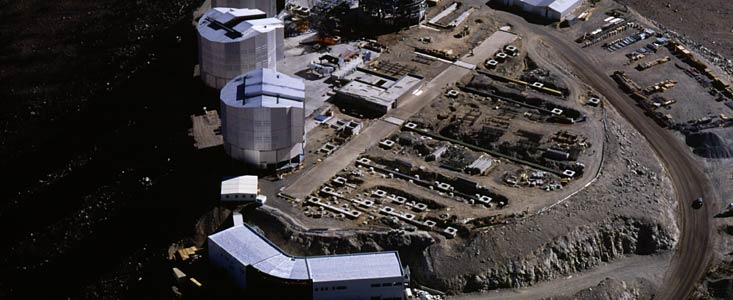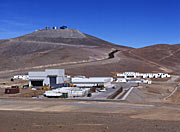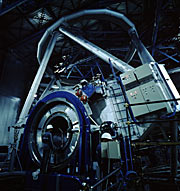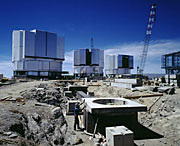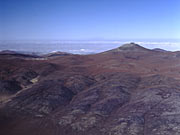Komunikat prasowy
High-resolution Photos from the Paranal Observatory
23 stycznia 1998
We show here five high-resolution photographic images (4-6 Mbytes) from the ESO Paranal Observatory, the site of ESO's Very Large Telescope Array (VLT).
They were obtained in December 1997 with a 6x6 cm Hasselblad camera by one of the professional photographers of the ESO EPR team. They have been selected with the specific purpose of providing editors with a choice of different views of ESO's new observatory at the present construction stage. It is here that the first of the four giant VLT 8.2-m Unit Telescopes (UT1) will enter into operation within a few months (the UT1 First Light Event).
For convenience, the present photos are also available in a smaller preview-size (300 - 600 kbytes). Note also that video clips are available on the web.
Other recent high-resolution photos are available from the M1 transport. More information is also present at the ESO website about the VLT project.
Więcej informacji
First SOFI Images
This series of astronomical images (and one spectrum) provides a demonstration of the impressive capabilities of the new ESO SOFI instrument which was recently tested at the 3.5-m New Techonology Telescope at La Silla, cf. ESO Press Release eso9805.
They were obtained by ESO astronomers Alan Moorwood (PI), Jean-Gabriel Cuby (Instrument Scientist) and Chris Lidman (NTT Support Astronomer) during the test.
This is a composite of three 1-min exposures of the Orion Nebula through narrow band filters centered on the 2.166 micron Br-gamma atomic hydrogen line (here reproduced in blue colour), the 1.257 micron [FeII] line (green) and the 2.12 micron 1-0 S(1) molecular hydrogen line (red). The colour coding reflects the ionization state of the gas.
Br-gamma traces hydrogen gas that is ionized by the well known Trapezium and other hot, young, stars in the region; the [FeII] emission is emitted by high velocity fragments ejected during the birth of new stars in the OMC1 molecular cloud. The hollow filaments seen in molecular hydrogen result from shock heating of the molecular gas in the wake of the outflowing matter.
In this image, the scale is 0.29 arcsec/pixel; the field is 5x5 arcmin with North at the top and East to the left; The seeing was around 0.5 arcsec. (Colour composite by N. Devillard).
This is a short (12 sec) exposure of the globular cluster NGC1261 through an H-filter centered at 1.65 micron. Note the excellent resolution, achievable at this wavelength with the SOFI/NTT combination.
The field measures 2.5 x 2.5 arcmin, with North at the top and East to the left. The scale is 0.14 arcsec/pixel. The stellar images are very sharp (FWHM around 0.7 arcsec).
Next follows a composite of three narrow-band filter exposures of the famous Tarantula Nebula (30 Doradus) in our closest neighbouring galaxy, the Large Magellanic Cloud. The filters are centred on the 2.166 micron Br-gamma line of atomic hydrogen (blue); the 1.644 micron [FeII] line (green) and the 2.12 micron 1-0 S(1) line of molecular hydrogen (red). The colour coding reflects the ionization state of the gas.
The scale is 0.26 arcsec/pixel and the field is 4.5x4.5 arcmin with North at the top and East to the left. (Colour composite by F. Selman).
J band image (1.25 micron) of the galaxy cluster Abell 370 (A370; redshift z = 0.375), obtained in 'jitter' mode, showing the famous gravitational arc just below the centre. The observations consisted of 24 exposures of 2 min each, made on randomly generated telescope positions within a sky region of 30 x 30 arcsec. The individual exposures have been sky subtracted using a running average determined from the same data and then re-centred and combined.
The scale is 0.29 arcsec/pixel; the field is about 5 x 5 arcmin with North at the top and East to the left. The seeing was less optimal, about 1.2 arcsec. A J = 22 mag point source yields a signal-to-noise ratio of 4 within a 3 arcsec diameter aperture.
Radio Galaxy MRC 0406-244
This is another 'jittered' image of a 5x5 arcmin field, this time in a Ks (2.16 micron) filter and showing the radio galaxy MRC 0406-244 (redshift z = 2.4); it is identified by the arrow.
North is at the top and East to the left; the scale is 0.29 arcsec/pixel and the FWHM of point sources in this re-combined set of 38 1-min exposures is about 0.7 arcsec. A K = 21 mag point source yields a signal-to-noise ratio of 4 within a 1.5 arcsec diameter aperture.
A spectrum, covering the 1.6 - 2.45 micron infrared wavelength region was obtained with SOFI's 'red grism' of the radio galaxy MRC 0406-244 showing the redshifted 'visible' [OIII] doublet (emission from double-ionized oxygen atoms at rest wavelength 4959A and 5007A) and H-alpha (6563 A) emission lines. The oxygen lines are seen to the left and the hydrogen line is in the right half of the diagramme.
The 1.8 - 2.0 micron spectral region suffers from absorption in the terrestrial atmosphere and has been removed. After identifying the galaxy in a 1-min imaging exposure and centering it in the 2 arcsec wide entrance slit, four spectral exposures were obtained, each lasting 15 minutes, on two positions along the slit, to permit cancellation of sky emission lines and produce the `clean' spectrum shown here.
Additional information and images are available at the SOFI Homepage.
O komunikacie
| Komunikat nr: | eso9804 |
| Legacy ID: | Photo 02a-e/98 |
| Nazwa: | Atacama Desert, Cerro Paranal, Paranal, Very Large Telescope, VLT Unit Telescopes |
| Typ: | Unspecified : Technology : Observatory Unspecified : Technology : Observatory : Telescope |
| Facility: | Very Large Telescope |
Our use of Cookies
We use cookies that are essential for accessing our websites and using our services. We also use cookies to analyse, measure and improve our websites’ performance, to enable content sharing via social media and to display media content hosted on third-party platforms.
ESO Cookies Policy
The European Organisation for Astronomical Research in the Southern Hemisphere (ESO) is the pre-eminent intergovernmental science and technology organisation in astronomy. It carries out an ambitious programme focused on the design, construction and operation of powerful ground-based observing facilities for astronomy.
This Cookies Policy is intended to provide clarity by outlining the cookies used on the ESO public websites, their functions, the options you have for controlling them, and the ways you can contact us for additional details.
What are cookies?
Cookies are small pieces of data stored on your device by websites you visit. They serve various purposes, such as remembering login credentials and preferences and enhance your browsing experience.
Categories of cookies we use
Essential cookies (always active): These cookies are strictly necessary for the proper functioning of our website. Without these cookies, the website cannot operate correctly, and certain services, such as logging in or accessing secure areas, may not be available; because they are essential for the website’s operation, they cannot be disabled.
Functional Cookies: These cookies enhance your browsing experience by enabling additional features and personalization, such as remembering your preferences and settings. While not strictly necessary for the website to function, they improve usability and convenience; these cookies are only placed if you provide your consent.
Analytics cookies: These cookies collect information about how visitors interact with our website, such as which pages are visited most often and how users navigate the site. This data helps us improve website performance, optimize content, and enhance the user experience; these cookies are only placed if you provide your consent. We use the following analytics cookies.
Matomo Cookies:
This website uses Matomo (formerly Piwik), an open source software which enables the statistical analysis of website visits. Matomo uses cookies (text files) which are saved on your computer and which allow us to analyze how you use our website. The website user information generated by the cookies will only be saved on the servers of our IT Department. We use this information to analyze www.eso.org visits and to prepare reports on website activities. These data will not be disclosed to third parties.
On behalf of ESO, Matomo will use this information for the purpose of evaluating your use of the website, compiling reports on website activity and providing other services relating to website activity and internet usage.
Matomo cookies settings:
Additional Third-party cookies on ESO websites: some of our pages display content from external providers, e.g. YouTube.
Such third-party services are outside of ESO control and may, at any time, change their terms of service, use of cookies, etc.
YouTube: Some videos on the ESO website are embedded from ESO’s official YouTube channel. We have enabled YouTube’s privacy-enhanced mode, meaning that no cookies are set unless the user actively clicks on the video to play it. Additionally, in this mode, YouTube does not store any personally identifiable cookie data for embedded video playbacks. For more details, please refer to YouTube’s embedding videos information page.
Cookies can also be classified based on the following elements.
Regarding the domain, there are:
- First-party cookies, set by the website you are currently visiting. They are stored by the same domain that you are browsing and are used to enhance your experience on that site;
- Third-party cookies, set by a domain other than the one you are currently visiting.
As for their duration, cookies can be:
- Browser-session cookies, which are deleted when the user closes the browser;
- Stored cookies, which stay on the user's device for a predetermined period of time.
How to manage cookies
Cookie settings: You can modify your cookie choices for the ESO webpages at any time by clicking on the link Cookie settings at the bottom of any page.
In your browser: If you wish to delete cookies or instruct your browser to delete or block cookies by default, please visit the help pages of your browser:
Please be aware that if you delete or decline cookies, certain functionalities of our website may be not be available and your browsing experience may be affected.
You can set most browsers to prevent any cookies being placed on your device, but you may then have to manually adjust some preferences every time you visit a site/page. And some services and functionalities may not work properly at all (e.g. profile logging-in, shop check out).
Updates to the ESO Cookies Policy
The ESO Cookies Policy may be subject to future updates, which will be made available on this page.
Additional information
For any queries related to cookies, please contact: pdprATesoDOTorg.
As ESO public webpages are managed by our Department of Communication, your questions will be dealt with the support of the said Department.
